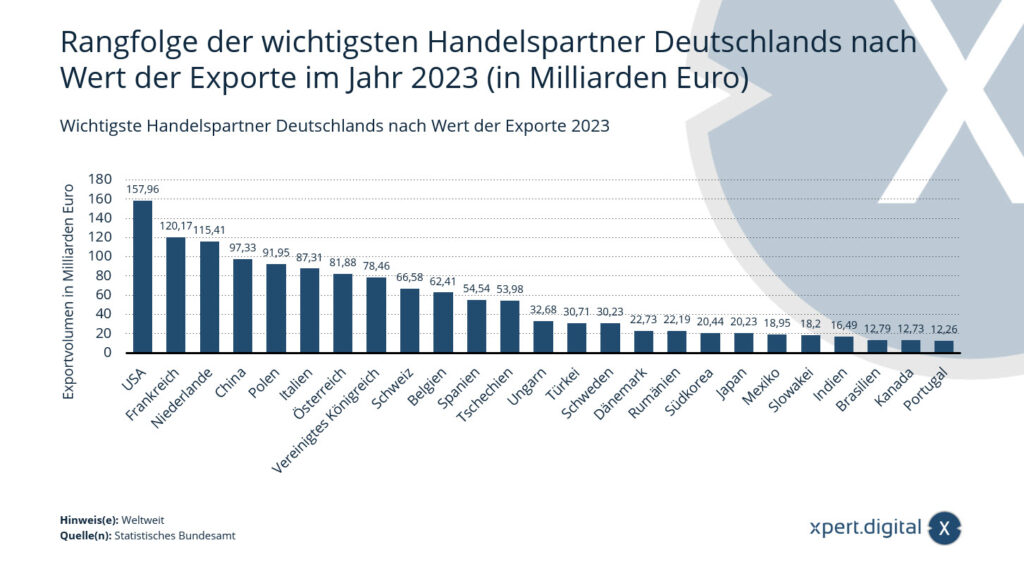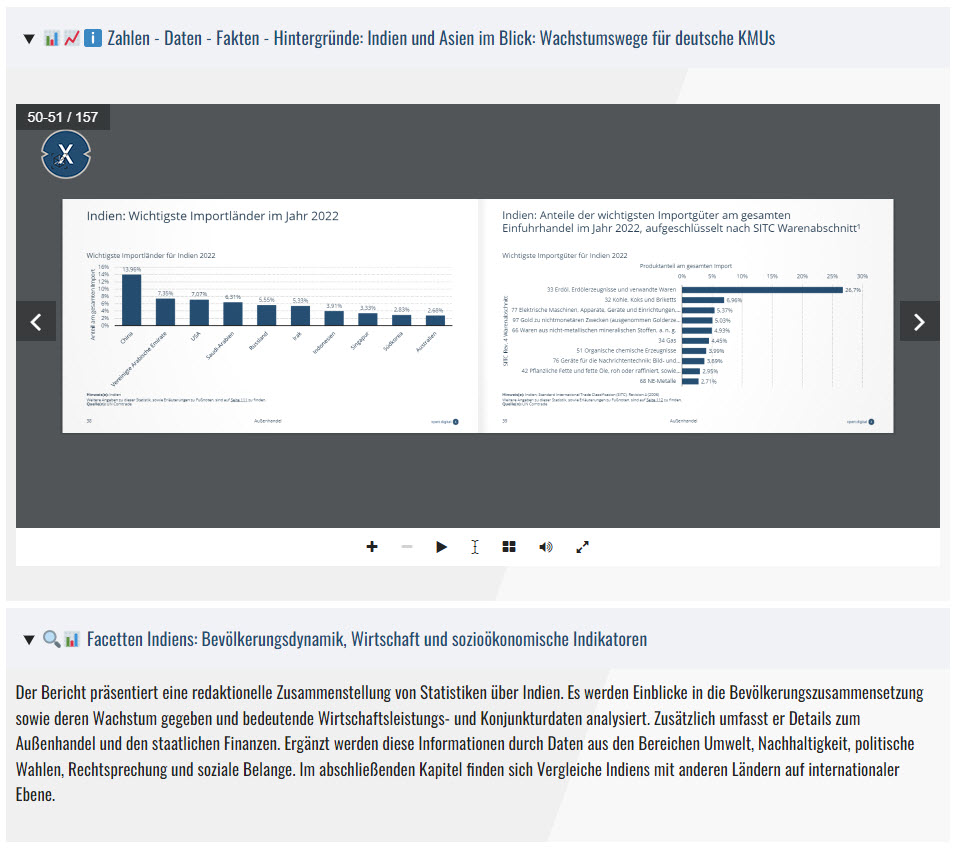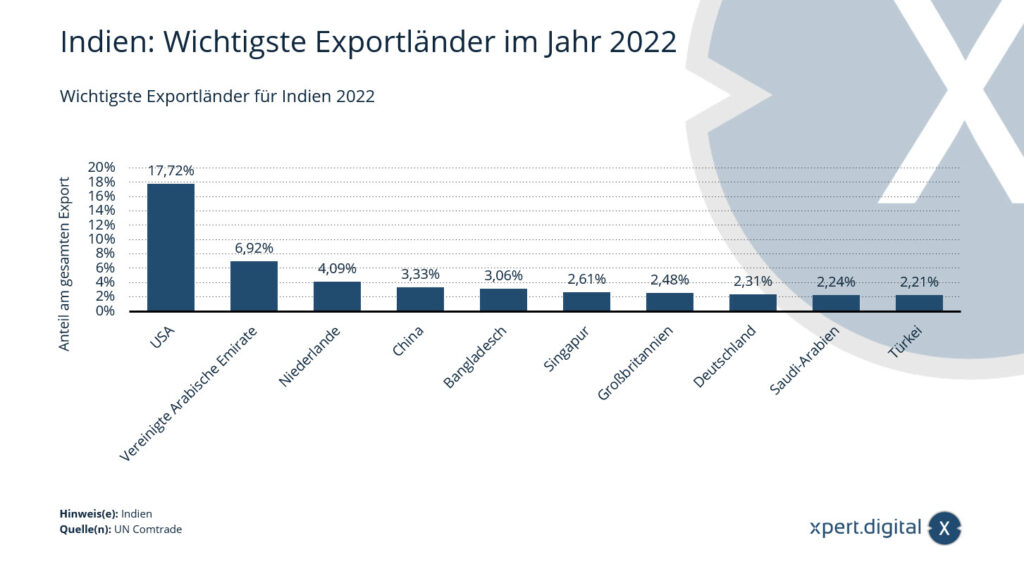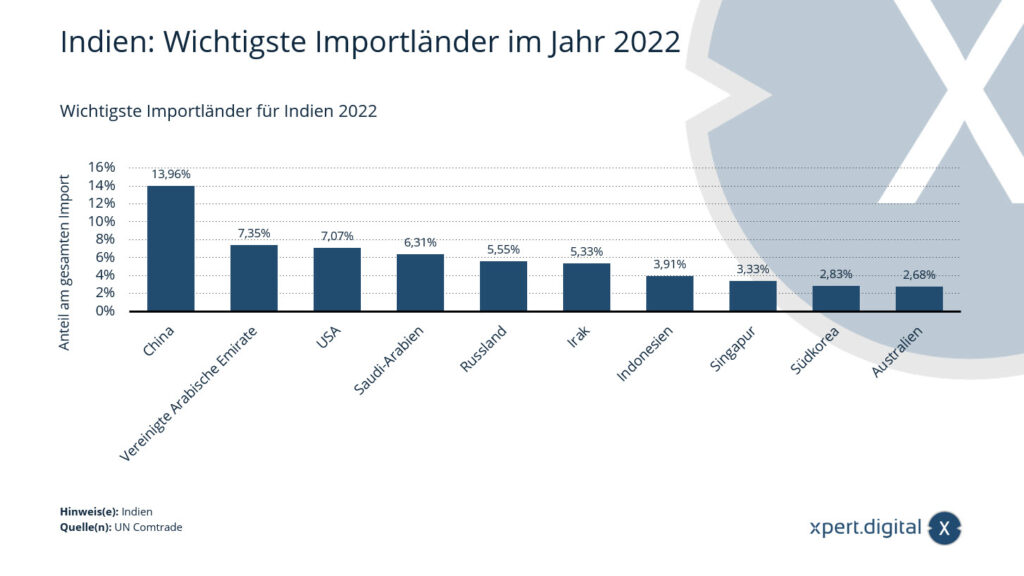New markets, new opportunities: India and Asia as a springboard for German SMEs – with B2B trading platforms and more
Language selection 📢
Published on: April 26, 2024 / update from: April 26, 2024 - Author: Konrad Wolfenstein

Grow without limits: Strategies for the entry of German SMEs into India and the Asian region - Image: Xpert.Digital
💼🌏 The economic relations between Germany and India
📈 Trading volumes and positions
The economic relations between Germany and India, two states that are playing an increasingly important role on the global stage, are multifaceted and complex. While Germany is known as one of the largest economies in the world, India stands out for its rapid growth and position as one of the most populous nations. The trade relations between these two countries offer a fascinating range of opportunities, challenges and development potential.
In 2023, Germany's export volume to India was only 16.49 billion euros, which puts India in 22nd place among Germany's most important trading partners. This number may seem surprising at first, especially when you compare it with the export volumes of smaller countries such as Switzerland (66.58 billion euros) or Belgium (62.41 billion euros). This discrepancy raises questions about the reasons for these relative positions and what this means for the future of trade relations between Germany and India.

Ranking of Germany's most important trading partners by value of exports in 2023 (in billion euros) - Xpert.Digital
From India's side, goods worth around 14.32 billion euros were exported to Germany in the same year. This places India in 24th place in the ranking of Germany's most important import sources. In contrast to this is India's trade balance, which with a deficit of -270.61 billion euros is the second largest in the world after the USA, where, for example, India's share of imports from China is 13.96% and the share of exports to China is only 3.33%. lies.

Ranking of Germany's most important trading partners by value of imports in 2023 (in billion euros) - Image: Xpert.Digital
A trade deficit occurs when the value of a country's imports exceeds the value of its exports. This means that the country in question buys more goods and services from other countries than it sells to other countries. The balance of trade is an important part of a country's balance of payments and refers specifically to trade in physical goods and, depending on the definition, sometimes services.
A trade deficit is not inherently negative. It can have various causes and effects depending on a country's economic situation, its industrial structure and its role in the global trading system. Some possible reasons for a trade deficit include:
- A high level of domestic consumption and investment, leading to increased demand for imported goods.
- A strong currency that makes imports cheaper and exports more expensive.
- Structural changes in the economy or in specific sectors that affect competitiveness.
- Lower production costs abroad, leading to relocation of production.
However, in the long term, persistent trade deficits can lead to foreign indebtedness, as they are often financed through external debt or the sale of domestic assets. This, in turn, can affect a country's macroeconomic stability, especially if debt is not sustainable or is not invested in productive assets.
Countries respond to trade deficits in a variety of ways, including by adjusting their monetary policies, promoting exports, restricting imports, or applying structural reforms to increase their competitiveness. The appropriate response depends on the specific causes and circumstances of the deficit.
🌐 Significance for the trade landscape: India is currently not a primarily important trading partner for Germany - vice versa
At first glance, these figures suggest that India is currently not a primarily important trading partner for Germany. However, the picture on the Indian side is slightly different. In the ranking of export destinations for Indian goods, Germany takes 8th place with a share of 2.31% of India's total export volume. The USA tops this list with a significant share of 17.72%, followed by the United Arab Emirates with 6.92%. Other countries such as the Netherlands, China, Bangladesh, Singapore and Great Britain are similarly grouped around Germany's share of the area, making Germany a not unimportant buyer of Indian goods.
- India: Most important export countries in 2022 – Xpert.Digital
- India: Most important import countries in 2022 – Xpert.Digital
These apparently sober statistics hide an ocean to “unable potential” and dynamic interactions. Germany, as a leading power in technology, engineering, automotive industry and renewable energies, offers India not only a market for its goods, but also a source for technological know-how and investments. At the same time, the young, rapidly growing and increasingly consumed Indian audience offers the German market opportunities in the field of export and strategic partnerships in areas such as digital technologies, energy, environmental protection and education.
🔮 Future perspectives
Looking ahead, trade relations between these two countries are constantly changing. Future agreements could lead to an intensification of trade relations, particularly in areas such as the digital economy and sustainable development, which both countries value highly. Various factors such as political changes, the global economic situation and technological breakthroughs will further influence the development of these relationships.
💰 Foreign direct investment
In addition to trade dynamics, foreign direct investment (FDI) plays a significant role in the interconnectedness of the two economies. Germany is one of the largest foreign investors in India, with a strong focus on the manufacturing sector, automotive industry and technology projects. These investments not only strengthen India's economy but also contribute to job creation and technology transfer.
🤝 Cultural and scientific exchange
The cultural and scientific exchanges between Germany and India offer a further dimension to bilateral relations. German universities and research institutes attract thousands of Indian students and researchers every year. At the same time, interest in Indian culture, language and knowledge is growing in Germany. These connections promote better mutual understanding and form a solid foundation for a strong and lasting partnership.
🌱 Growth potential and challenges
The trade relations between Germany and India may currently appear limited in certain aspects, but they have enormous potential for growth and deepening. Both countries face the challenge of actively seizing these opportunities and investing in a common future that not only serves their own interests, but also makes a positive contribution to the global economy and stability. The key to successfully expanding these relationships is identifying existing hurdles and overcoming them through collaborative efforts, visionary policymaking and leveraging technological innovation.
📣 Similar topics
- 🌍 Growing economic partnership between Germany and India
- 📊 Germany's trade relations with India: An analysis of the current figures
- 🤝 India and Germany: A comparison of their trading positions
- 💡 The untapped potential of German-Indian economic relations
- 🏭 Key sectors in German-Indian trade dynamics
- 🌱 Sustainable development and the digital economy: future prospects
- 💼 The importance of foreign direct investment in the connection between Germany and India
- 🎓 Cultural and scientific exchanges as the basis of bilateral relations
- 🚀 Technology sector as a bridge between German and Indian markets
- 🌟 The role of Germany and India in a globalized world economy
#️⃣ Hashtags: #GermanyIndiaTrade #Economic Relations #Foreign Trade Dynamics #Technology Partnership #Bilateral Investments
📊🔍 Data and numbers for the graphics and statistics
Measurement of foreign trade
The exchange of goods and services across national borders defines a country's foreign trade. This exchange is divided into exports (export of goods) and imports (import of goods). The difference between the value of a country's exports and imports forms the foreign trade balance. A country that exports more than it imports has a positive foreign trade balance, known as an export surplus.
Germany's role in foreign trade
Due to its persistent surpluses in the export sector, the Federal Republic of Germany is often referred to as an export nation or even the world export champion. Germany's top three imported goods categories recently included vehicles and vehicle parts, data processing equipment and electrical equipment.
Germany's most important trading partners by value of imports in 2023
In 2023, the preliminary value of goods imported from China to Germany amounted to around 157.1 billion euros, making China the most important import partner for Germany. The Netherlands then came in second and third place with imports worth 105 billion euros and the United States with imports worth 94.6 billion euros. Further information on Germany's main export partners in 2023 based on their export value is also available.
- China – 157.12 billion euros
- Netherlands – 105 billion euros
- USA – 94.62 billion euros
- Poland – 81.65 billion euros
- Italy – 72.19 billion euros
- France – 69.84 billion euros
- Czech Republic – 60.99 billion euros
- Austria – 54.60 billion euros
- Belgium – 53.23 billion euros
- Switzerland – 51.83 billion euros
- Spain – 39.18 billion euros
- Hungary – 37.31 billion euros
- United Kingdom – 36.67 billion euros
- Norway – 30.55 billion euros
- Japan – 25.64 billion euros
- Ireland – 25.58 billion euros
- Türkiye – 24.35 billion euros
- Slovakia – 20.77 billion euros
- Romania – 19.52 billion euros
- Sweden – 18.93 billion euros
- Taiwan – 15.86 billion euros
- Denmark – 14.92 billion euros
- India – 14.32 billion euros
- Vietnam – 13.65 billion euros
- South Korea – 13.57 billion euros
Germany's most important trading partners by value of exports in 2023
- USA – 157.96 billion euros
- France – 120.17 billion euros
- Netherlands – 115.41 billion euros
- China – 97.33 billion euros
- Poland – 91.95 billion euros
- Italy – 87.31 billion euros
- Austria – 81.88 billion euros
- United Kingdom – 78.46 billion euros
- Switzerland – 66.58 billion euros
- Belgium – 62.41 billion euros
- Spain – 54.54 billion euros
- Czech Republic – 53.98 billion euros
- Hungary – 32.68 billion euros
- Türkiye – 30.71 billion euros
- Sweden – 30.23 billion euros
- Denmark – 22.73 billion euros
- Romania – 22.19 billion euros
- South Korea – 20.44 billion euros
- Japan – 20.23 billion euros
- Mexico – 18.95 billion euros
- Slovakia – 18.20 billion euros
- India – 16.49 billion euros
- Brazil – 12.79 billion euros
- Canada – 12.73 billion euros
- Portugal – 12.26 billion euros
India: Most important export countries in 2022
India's most important export country in 2022 is the USA, with a share of around 17.7 percent of exports. The United Arab Emirates is India's second most important trading partner with an export share of around 6.9 percent in 2022.
- USA – 17.72 in %
- United Arab Emirates – 6.92 in %
- Netherlands – 4.09 in %
- China – 3.33%
- Bangladesh – 3.06 in %
- Singapore – 2.61 in %
- Great Britain – 2.48 in %
- Germany – 2.31 in %
- Saudi Arabia – 2.24 in %
- Türkiye – 2.21 in %
India: Most important import countries in 2022
India's most important importing country in 2022 is China, with a share of around 14 percent of imports. The United Arab Emirates is the second most important import partner with an import share of around 7.35 percent of India's total imports.
- China – 13.96%
- United Arab Emirates – 7.35 in %
- USA – 7.07 in %
- Saudi Arabia – 6.31 in %
- Russia – 5.55 in %
- Iraq – 5.33 in %
- Indonesia – 3.91 in %
- Singapore – 3.33 in %
- South Korea – 2.83 in %
- Australia – 2.68 in %
📊📈ℹ️ Numbers - data - facts - background: India and Asia in view: growth paths for German SMEs

Figures – Data – Facts – Background: India and Asia at a glance: Growth paths for German SMEs – Image: Xpert.Digital
We currently no longer offer our newer PDFs for download. These are only available upon direct request.
However, the PDF “India” (157 pages) can be found in our
📜🗺️ Infotainment portal 🌟 (e.xpert.digital)
under
https://e.xpert.digital/indien/
with the password: xindia
view.
📊🔗 Connected future: Understanding and using challenges and opportunities in German-Indian trade
🌏🤝 The path that Germany and India can take in their bilateral trade relations is largely determined by various factors. It is essential to recognize the current challenges and opportunities in order to develop a strategy for a sustainable and growth-oriented future.
📊🔑 Addressing trading challenges
Trade barriers
Trade barriers, whether tariff or non-tariff, often stand in the way of more interconnected trade. Eliminating or reducing tariffs, simplifying customs procedures and reducing bureaucratic barriers could have far-reaching positive effects on bilateral trade. A first step could be to explore a free trade agreement or a preferential trade agreement specifically tailored to the needs and capacities of both countries.
Market access
Easier market access conditions could make a big difference, especially for German companies that want to enter the Indian market. India could also benefit if its exports were promoted through simplified approval procedures or greater integration into German supply chains.
💡🌱 Exploit potential
Technology and innovation
Germany, as one of the leading nations in the areas of technology and innovation, can rely on a partnership with India to work together, for example, in the areas of digitalization, renewable energies and sustainable agriculture. Projects that focus on the development and implementation of green technologies, digital education solutions or smart city initiatives offer valuable opportunities for close collaboration.
Promote investments
Foreign direct investment (FDI) represents another area of action. Promoting German investments in India, as well as encouraging Indian companies to invest in Germany, could deepen the economic ties between the two nations. This also includes investing in education and training to ensure that the population meets the changing demands of the labor market.
📘🌐 Cultural and scientific cooperation
Educational and research collaborations
Deepening scientific and academic cooperation between Germany and India can serve as the basis for a lasting partnership. Promoting academic exchanges and joint research projects in key areas could help strengthen ties and encourage innovative thinking.
Cultural exchange
Culture is a powerful bond between nations. Promoting cultural exchange and mutual understanding through art, music, literature and film can take the relationship to a more personal level and lay the foundation for a long-term partnership.
🚀🔮 Potential for a more intense and beneficial trading relationship
The potential for a more intensive and beneficial trade relationship between Germany and India is enormous. Both countries have unique strengths to bring to a partnership and common interests to pursue. However, the future of this bilateral relationship depends on the ability of both nations to address common challenges, promote mutual respect and work together in a sustainable and inclusive manner.
In a world characterized by rapid technological advances, global challenges and changing geopolitical landscapes, Germany and India could serve as an example of a successful, forward-looking partnership that benefits not only their own peoples but also the global community. Through joint efforts and a vision for the future, both countries can usher in a new era of cooperation characterized by innovation, growth and mutual understanding.
📣 Similar topics
- 🌍 Future prospects for German-Indian trade relations
- 💡 Innovation and technology as a bridge between Germany and India
- 🤝 The role of cultural and scientific exchange in the German-Indian partnership
- 💼 Strategies for overcoming trade barriers between Germany and India
- 📈 Promoting investments as the key to deepening German-Indian economic relations
- 🌱 Green technologies and sustainable agriculture: opportunities for Germany and India
- 🎓 Education and research: foundations for a strong German-Indian future
- 🔄 The importance of mutual cultural exchange for close relationships
- 🚀 Potential of a German-Indian partnership in the area of digital innovation
- 🌟 Germany and India: pioneers of future-oriented global cooperation
#️⃣ Hashtags: #GermanIndianRelations #TradeAndInnovation #CulturalExchange #TechnologyPartnership #SustainableDevelopment
🔄📈 B2B trading platforms support – strategic planning and support for exports and the global economy with Xpert.Digital 💡
Business-to-business (B2B) trading platforms have become a critical part of global trade dynamics and thus a driving force for exports and global economic development. These platforms offer significant benefits to companies of all sizes, particularly SMEs – small and medium-sized businesses – which are often considered the backbone of the German economy. In a world where digital technologies are becoming increasingly prominent, the ability to adapt and integrate is crucial to success in global competition.
More about it here:
🌐 Potential for German SMEs in India, regardless of the political conditions. For example via B2B trading platforms
🔍📈 India is not only experiencing continuous economic growth, but also increasing digitalization in all areas of life. With over 560 million internet users in 2023, the subcontinent is the second largest online market in the world. This digital upswing is paving new paths for German SMEs in the business world, particularly through expansion using digital platforms.
💼 Potential through B2B trading platforms
🌍 Access to a broad market
India's huge population and growing middle class mean huge customer potential. B2B platforms enable German SMEs to reach a wide range of business customers in India, from start-ups to established companies. The diversity of industries, from technology to agriculture, offers German SMEs a broad basis for business opportunities.
🚀 Reduced barriers to market entry
Traditionally, international business relationships require significant upfront investments, such as establishing a physical presence or adapting to local regulations. B2B trading platforms significantly minimize these barriers by providing the infrastructure for transnational trade. They offer a simplified way to conduct business in India without German SMEs having to invest large amounts immediately.
🔄 Efficient business processes
Through the use of technology, B2B platforms provide efficient solutions for contacting, negotiating and completing transactions. They improve business processes through automated payment systems, logistics solutions and customer support. These platforms not only facilitate international trade, but also optimize operational processes.
✔️ Personalized and scalable options
B2B platforms offer individualized solutions tailored to the specific needs and budget of each company. German SMEs can adapt their presence and offerings on these platforms according to their capacities and strategic goals. This creates an environment in which business can be gradually scaled and expansion steps can be implemented in a calculable manner.
🚧 Challenges and solutions
⚖️ Cultural sensitivity
Doing business in India requires a deep understanding and respect for the local culture. It is advisable to invest in intercultural training or work with local partners in order to be able to act in a culturally sensitive manner.
🗣️ Language and communication
English is widely spoken as a business language in India, but using regional languages can make it easier to access certain market segments. German SMEs should invest in multilingual platforms or services to overcome communication barriers.
🤝 Build a local network
The importance of personal relationships in India cannot be underestimated. A strong local network can open doors and make doing business easier. German SMEs should consider strategic partnerships and alliances to gain a foothold and grow.
###🏁 Expansion of German SMEs to India
The expansion of German SMEs into India, particularly through the use of B2B trading platforms, promises significant business opportunities. The combination of a huge market, technological advances and reduced barriers to entry creates a favorable environment for German companies. By overcoming the challenges and adapting to local conditions, German SMEs can operate successfully in one of the most dynamic markets in the world.
This overview makes it clear that despite various challenges, the opportunities in India are enormous for German SMEs that are willing to adapt and get involved. With the right strategy, the necessary commitment and a deep understanding of the Indian market, German SMEs can benefit from the diverse opportunities and expand successfully.

🎯🎯🎯 Benefit from Xpert.Digital's extensive, fivefold expertise in a comprehensive service package | R&D, XR, PR & SEM

AI & XR 3D Rendering Machine: Fivefold expertise from Xpert.Digital in a comprehensive service package, R&D XR, PR & SEM - Image: Xpert.Digital
Xpert.Digital has in-depth knowledge of various industries. This allows us to develop tailor-made strategies that are tailored precisely to the requirements and challenges of your specific market segment. By continually analyzing market trends and following industry developments, we can act with foresight and offer innovative solutions. Through the combination of experience and knowledge, we generate added value and give our customers a decisive competitive advantage.
More about it here:
We are there for you - advice - planning - implementation - project management
☑️ SME support in strategy, consulting, planning and implementation
☑️ Creation or realignment of the digital strategy and digitalization
☑️ Expansion and optimization of international sales processes
☑️ Global & Digital B2B trading platforms
☑️ Pioneer Business Development
I would be happy to serve as your personal advisor.
You can contact me by filling out the contact form below or simply call me on +49 89 89 674 804 (Munich) .
I'm looking forward to our joint project.
Xpert.Digital - Konrad Wolfenstein
Xpert.Digital is a hub for industry with a focus on digitalization, mechanical engineering, logistics/intralogistics and photovoltaics.
With our 360° business development solution, we support well-known companies from new business to after sales.
Market intelligence, smarketing, marketing automation, content development, PR, mail campaigns, personalized social media and lead nurturing are part of our digital tools.
You can find out more at: www.xpert.digital - www.xpert.solar - www.xpert.plus





























